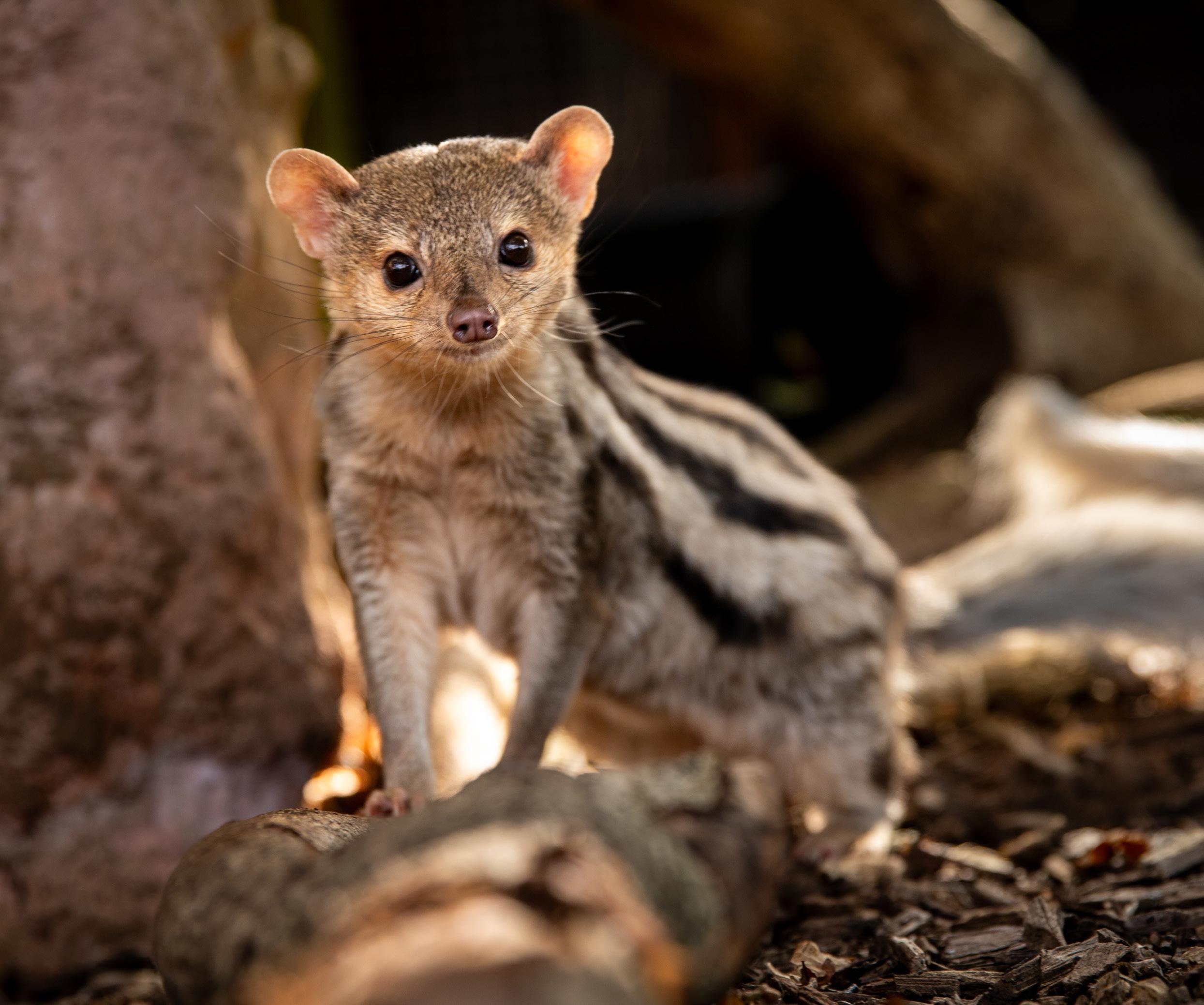
OFFICIAL GUIDEBOOK



OFFICIAL GUIDEBOOK

Ihave always been obsessed by animals, and by zoos. I believe, unequivocally, with absolute certainty, that we are improved as people if we have contact with, and appreciation of, animals. It was, therefore, the culmination of a personal dream to see the development of a small zoo at Bede’s.
Having a zoo at Bede’s is, I think, the apotheosis of what this school is all about. Bede’s is a school which thrives on doing things differently, on focusing on things that might not be obvious, and allowing them to flourish.
It is important, of course, to get the mainstream things right –we wouldn’t be much of a school if our English Department was poor, or our cricket side didn’t take things seriously – but it is equally important to allow the possibly esoteric, the apparently marginal, to flourish. Because, of course, what is marginal or esoteric to most will be central and fundamental to some.
For those who undertake Ceramics as a GCSE or A Level course, for example, their work with clay will possibly shape their future lives (and in a number of cases it has done just that); women’s cricket may not receive the attention which is given to that played by men, but our girls team have shown that their sport is every bit as important as that played by our boys. And the
investment and attention we have given to the Legat School of Dance has allowed many, many girls and boys to flourish in ways that would not have been possible at schools where there was no such commitment to dance.
And our school zoo, in which a small but significant number of pupils study and a greater number come in order to benefit from being able to spend time with animals, is the embodiment of our belief that all pupils should be given the opportunity to find their niche, to find the areas in which they can excel, and feel at home. As a school, we are enormously lucky to have such a facility in our midst.
In recent years, the need to connect with nature has been seen to be more vital than ever before. Being around animals is good for you, on so many different levels. Having a collection of animals within a school seems to be the most obvious and sensible decision we could possibly make!
John Tuson Deputy Head

In 2024, we surveyed the pupils at Bede’s to discover what the zoo meant to them.
Among the specific comments made by pupils were:
“The experience and knowledge that it gives me as someone who wants to work with animals, including the opportunity to speak to the keepers about zoology”
“It brings me joy, and a place to escape to from regular school life”
“I like that it is open to whoever wants to look round and help out but I also love that all the staff that are there are so helpful and love all the animals and care for them so well”
70%
of pupils agreed with the statement, “The opportunity to spend some of my school time with animals is something that is beneficial to my happiness”.
80%
of pupils agreed with the statement, “The opportunity to care for the animals within the zoo gives me a sense of responsibility”.
63%
of pupils agreed with the statement, “The opportunity to visit the zoo, and interact with the animals there, increases my sense of belonging”.
76%
of pupils agreed with the statement, “The opportunity to care for the animals within the zoo gives me a sense of responsibility”.
79%
of pupils agreed with the statement, “The opportunity to visit the zoo, and interact with the animals there, increases my sense of belonging”.
We aim to keep a varied cross-section of mammal species, providing pupils with different husbandry challenges whilst also presenting an attractive and interesting collection. We are also able to participate in several breeding programmes for endangered species, as well as providing a home for animals that have been bred in other British zoos.
Galidictis grandidieri
Sometimes known as the Grandidier’s Mongoose, the Vontsira isn’t really a mongoose at all, but, rather, is a Euplerid - a family of carnivores unique to Madagascar. The best known Euplerid is the Fossa; the Grandidier’s Vontsira is possibly the least known, found only in one small area of south-western Madagascar. Researchers in Madagascar report Vontsiras being friendly and unafraid of human contact - indeed, they have helped themselves to human provisions, particularly enjoying tinned fish! Their natural diet includes invertebrates and small mammals and birds.
Why do we keep Vontsiras? The captive population of Grandidier’s Vontsiras is tiny: there are currently eleven animals, kept in zoos in Germany, England and the United Arab Emirates. Those animals are all overseen by the Euplerid Foundation, based in the north of England, which hopes to establish the species in captivity so as to provide a “safety net” population should its wild population fall, and also to enable more to be learnt about this beautiful species. Bede’s was chosen as a location for some of the animals as it is possible for them to live here in relative peace and quiet - we don’t know how they would respond to living in a busy zoo, with many visitors.
Vontsiras at Bede’s We currently keep three Vontsiras: Ricky and Timmy, the two males, and Tripod. Our Vontsiras came to us in early 2022, from a private zoo in Cornwall. Tripod lost one of her legs after falling in her previous home; however, she copes superbly with just three legs, and is still incredibly agile. The Vontsiras’ outdoor enclosure was in part funded by the parents of Georgie
Cloke, a pupil at Bede’s between 2016 and 2021; Georgie was a superb Animal Management student, and left us to study Biomedical Science. Our animals are very settled here, but we may exchange them with Vontsiras in other collections as we try to encourage breeding of this very rare species.
This South and Central American relative of the Raccoon is well-adapted for a life in the trees: it is an excellent climber (thanks in large part to its prehensile tail) and eats a diet composed mainly of fruit (figs are a favourite). The Kinkajou is primarily active in the evening, and, in the wild, its time is split between eating, resting and moving from tree to tree.
Why do we keep Kinkajous? Because they are beautiful, interesting and charismatic animals, which provide us with various challenges – how best to keep an animal which is asleep for much of the day? How to stimulate such intelligent animals, keeping them active and engaged?
Kinkajous at Bede’s Our three Kinkajous – one male, two females – came to us from a private collection, in 2014. They are quite old animals, and so it is unlikely they will breed; however, plentiful environmental enrichment means that they are kept constantly busy. Look out for the walkway we have built for them, taking them beyond their enclosure, and sometimes making them work that little bit harder for their food. In 2023, teachers from our Inquiry Learning faculty worked together to build better cage furnishing for our Kinkajous, as part of a team building exercise.
Arctictis binturong
The Binturong’s scientific name - Arctictis - comes from the Greek for ‘bear-weasel’, and in English they are sometimes known as the ‘bear-cat’: neither of these descriptions is zoologically accurate! Binturongs are actually members of the Viverrid family, related to Civets and Genets. Native to south-east Asia, they will eat pretty much anything, and their most impressive feature is their long, muscular, prehensile tail. They use this to balance and also to hang on as they move through forests. Equally impressive is their smell: Binturongs have the odour of burnt popcorn! Vulnerable in the wild, Binturongs are under threat from forest clearance, and also from being hunted as a food item. Why do we keep Binturongs? Binturongs are charismatic, interesting, and rather loveable! They breed well in zoos, and our pair came to us when the zoo at which they had been born was struggling to be able to send them to a collection in mainland Europe. We were delighted to be able to offer them a home here in Sussex!
Binturongs at Bede’s Our Binturongs were both born at Hamerton Zoo, in Cambridgeshire. They settled in to their home here very quickly after arriving in December 2021. Paul Juniper, who is in charge of the Bede’s Zoo, helped to develop the husbandry guidelines for Binturongs when he worked at Southport Zoo, in the 1990s. The work that he and his colleagues undertook there has allowed the Binturong to flourish in captivity.
Saimiri sciureus
The large head of this small monkey is indicative of its intelligence: squirrel monkeys are inquisitive, adaptable animals, which has enabled them to flourish in a variety of environments. Small groups have established themselves in Florida – a long way from their natural home, in the Amazon Basin.
Why do we keep Squirrel Monkeys? Busy, intelligent, active – Squirrel Monkeys are excellent animals to be able to care for, and also to observe. Our animals present a constant challenge to those who care for them, who must strive to make sure that the monkeys’ life is stimulating and ever-changing.
Squirrel Monkeys at Bede’s Our monkeys are an all-male group; they came to us in the summer of 2018, from Bristol Zoo, where they had been bred and where there was a need to reduce the size of the group maintained. Here in Sussex they are constantly active and busy, constantly looking out for food, constantly interested in what is going on around them.




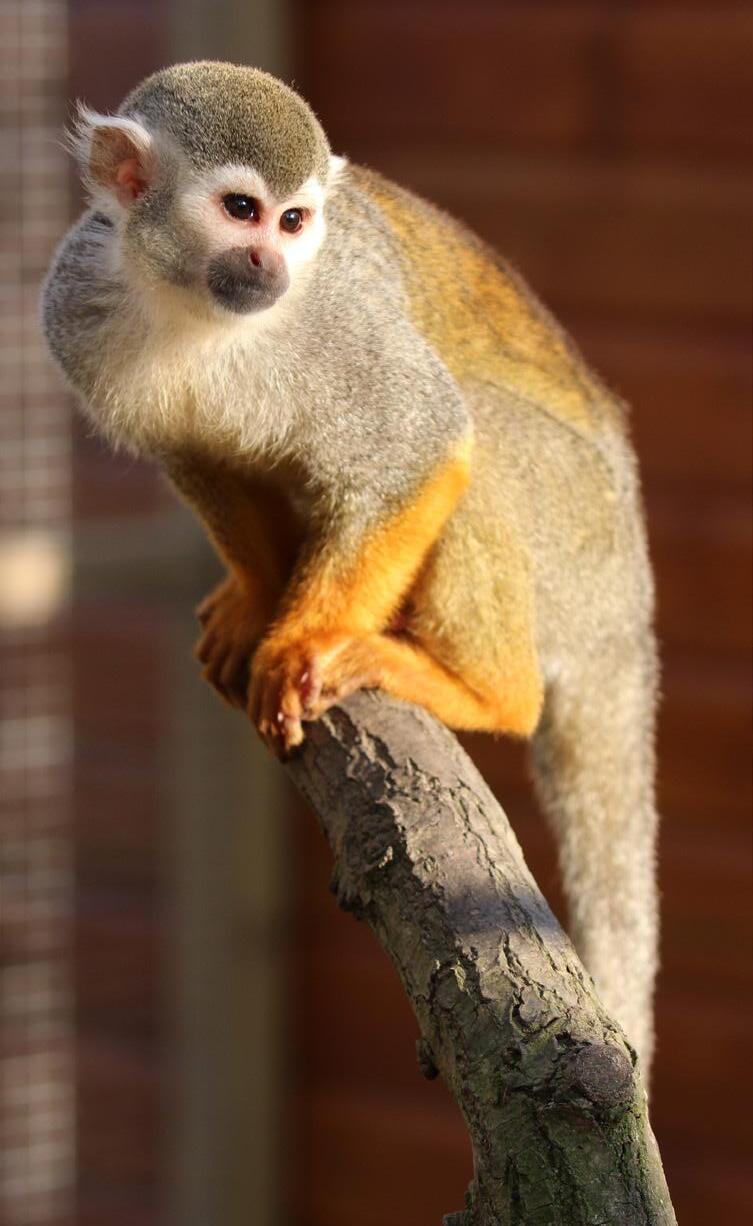
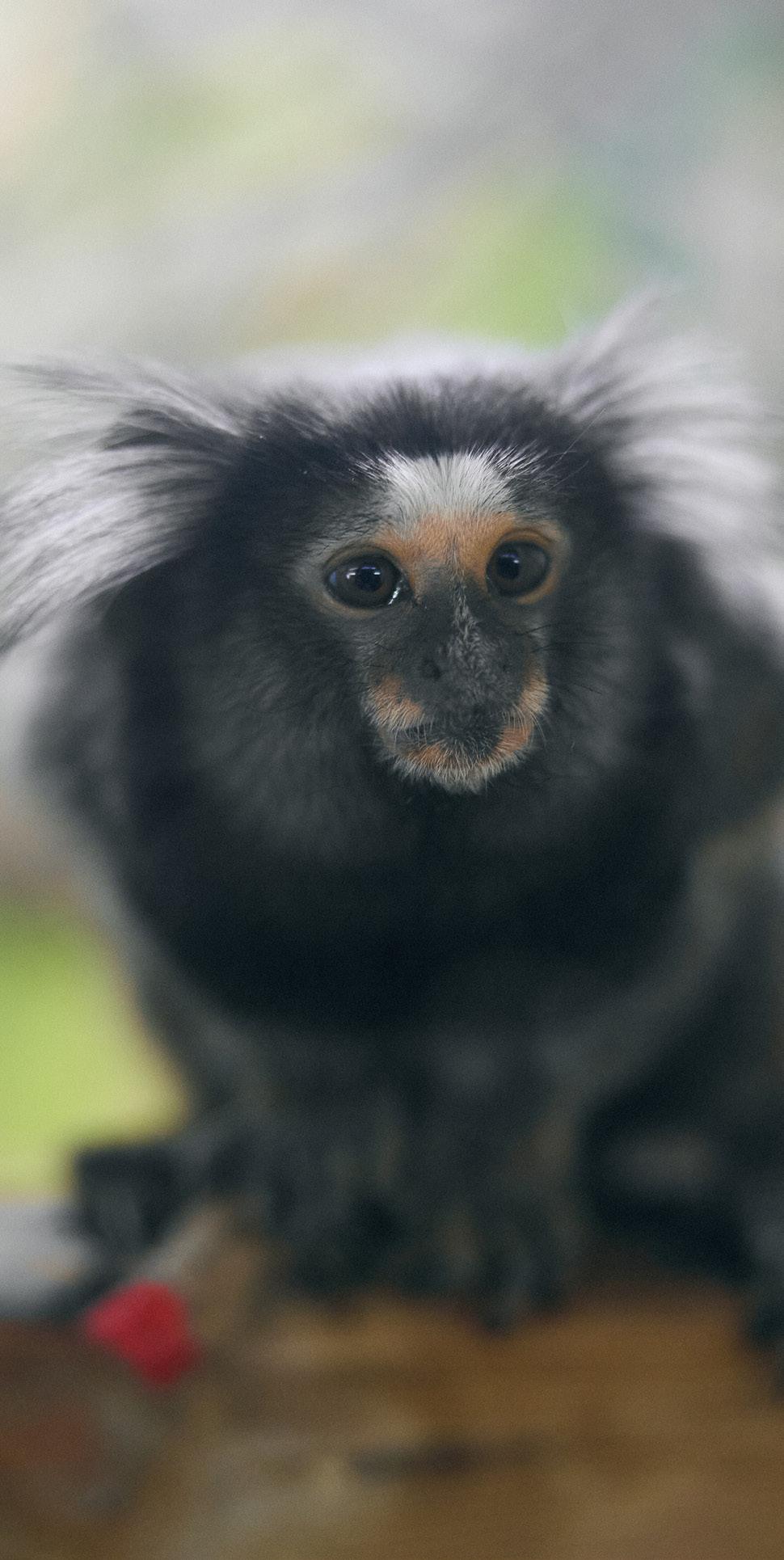


Callithrix jacchus
These small South American primates are vocal, active, social creatures. In the UK, they are still widely held as ‘pets’, often in woefully inadequate conditions. Why do we keep Marmosets? For a number of reasons! Our pair were being kept by an incompetent owner: living in an old-fashioned bird cage, and highly obese, they were not in good shape when we received them from a primate sanctuary. Not only did they need a home, but we needed experience of keeping Marmosets, in the hope that in the future we will be able to maintain a rarer species.
Marmosets at Bede’s Since arriving at Bede’s in 2019, our pair of Marmosets have lost weight, become a great deal more active and look to be enjoying life.
Muscardinus avellanarius
The Hazel Dormouse is found throughout much of Europe, but its British population has fallen markedly in recent years. Hibernating through the winter, the Dormouse earns it reputation for laziness – although, come the spring, it is active and busy, albeit largely nocturnal.
Why do we keep Dormice? We are proud to participate in a nationwide breeding programme for the Hazel Dormouse, co-ordinated by Paignton Zoo. Animals bred at Bede’s have helped the wild population to grow, having been returned to the wild in the north of England.
Dormice at Bede’s We initially received Hazel Dormice in 2013; since then we have bred more than 30 youngsters, with 12 arriving in the spring of 2019. Staff and pupils at Bede’s have been actively involved in the building of nest boxes for wild Dormice, and the monitoring of nearby wild populations.
Notomys alexis
This unusual rodent is a native of western and central Australia. It has long back legs, enabling it to ‘hop’ in its desert home.
Why do we keep Hopping Mice? Plentiful in the wild, and in Australian zoos, these rodents are almost unknown outside their homeland. The Australian government is very strict about the exportation of animals, and when it allowed a small group of Hopping Mice to come to Hamerton Zoo, in Cambridgeshire, put down strict guidelines as to where any animals that were bred there could be moved. We were delighted to take a small group of mice from them, to help manage the British population of this species.
Hopping Mice at Bede’s We have to be careful not to breed too many Hopping Mice - it would be easy to be overrun by them! We therefore keep males and females separately, and only put them together when breeding is required.
Cavia porcellus
One of the most popular domesticated species to be found in homes in the UK – kept mainly, now, for companionship rather than for food.
Why do we keep Guinea Pigs? Our pupils need to learn to handle animals; Guinea Pigs enable them to start to do so with confidence.
Guinea Pigs at Bede’s We have kept Guinea Pigs since the Bede’s Zoo was first established.
Echinops telfairi
They look like hedgehogs and behave like hedgehogs, but these Madagascan mammals are not closely related to the more familiar species.
Why do we keep Tenrecs? They’re interesting and relatively low-maintenance - in the wild, they hibernate for six months of the year, so these are not animals that expect a busy lifestyle!
Tenrecs at Bede’s Our pair have been together since the end of 2023, so we hope they will breed soon - their litters can be quite large!
Arvicanthis neumanni
There are hundreds of different murid (rat and mouse) species to be found in Africa; this is just one of them. Busy and social - they are always active and easily visible.
Why do we keep Grass Rats? They’re a fascinating species, and their fecundity provides an interesting challenge - they breed very quickly, so we need to make sure we are not over-run by them!
Grass Rats at Bede’s We keep our males and females apart, so as to prevent excessive breeding.
Thallomys paedulcus
A pretty rodent, found across central Africa, this species normally lives in Acacia trees - as its name suggests. Why do we keep Acacia Rats? A little bit shy and secretive, the Acacia Rat is an interesting animal to maintain at the zoo.
Acacia Rats at Bede’s We currently keep two femalesso no reproduction is possible! Males are hard to find, but we would love to be able to breed these beautiful animals.
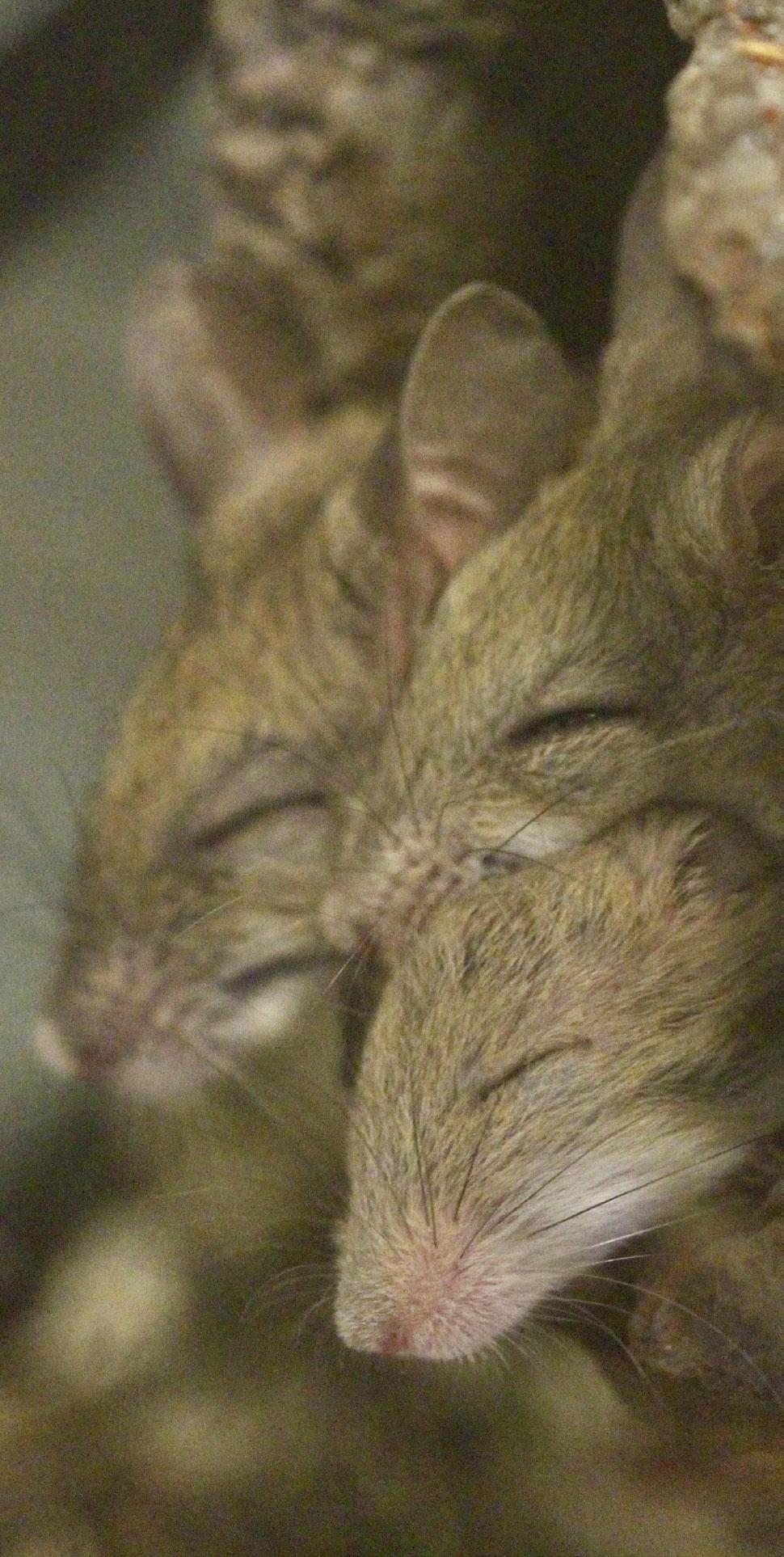

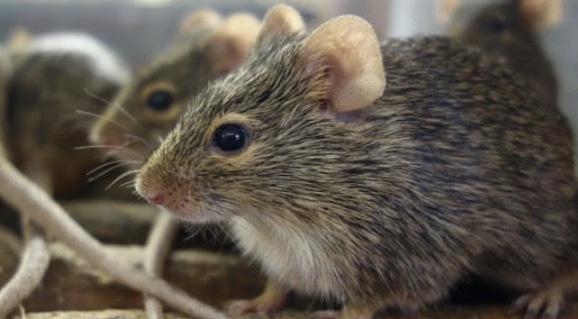
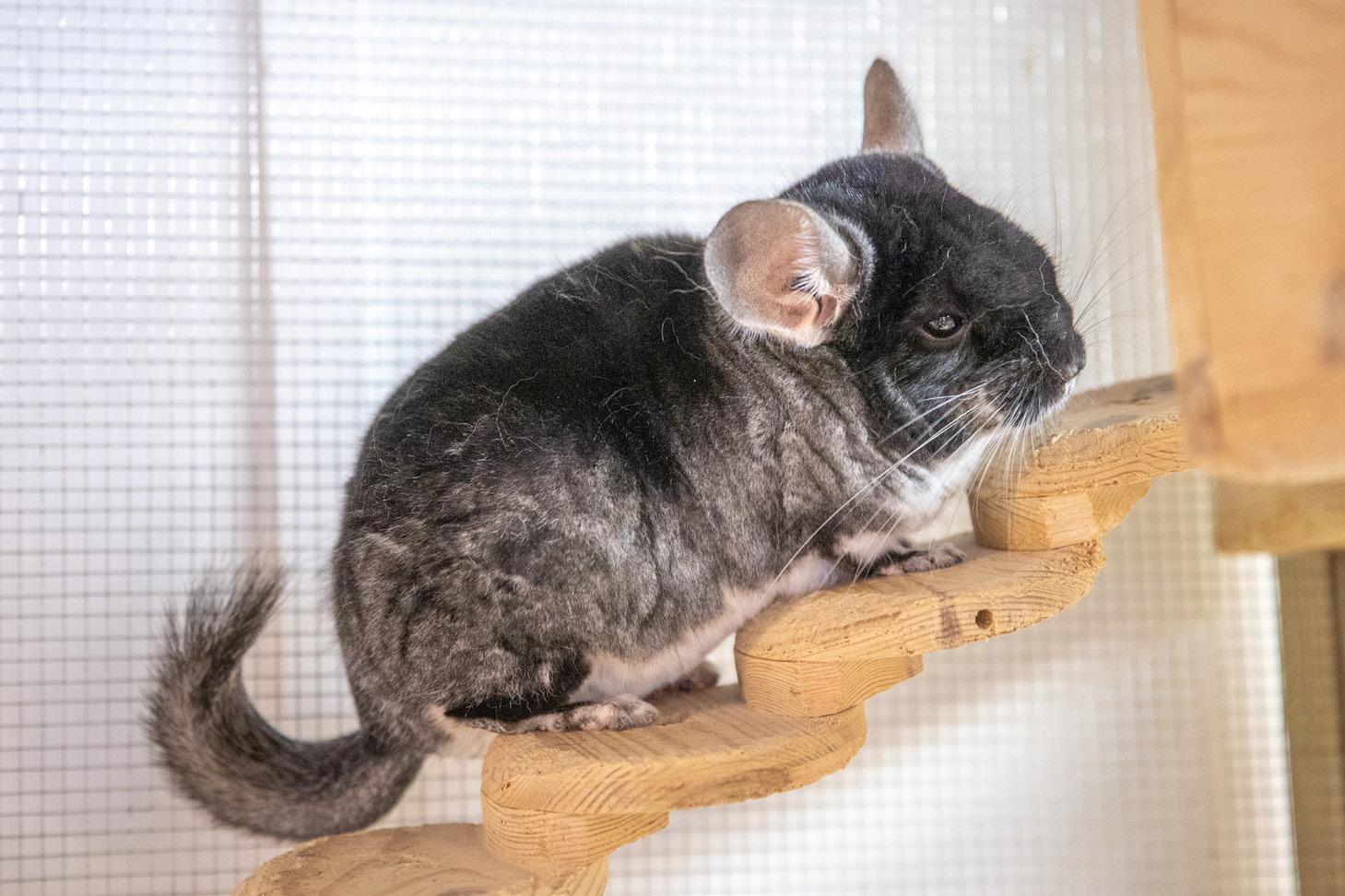

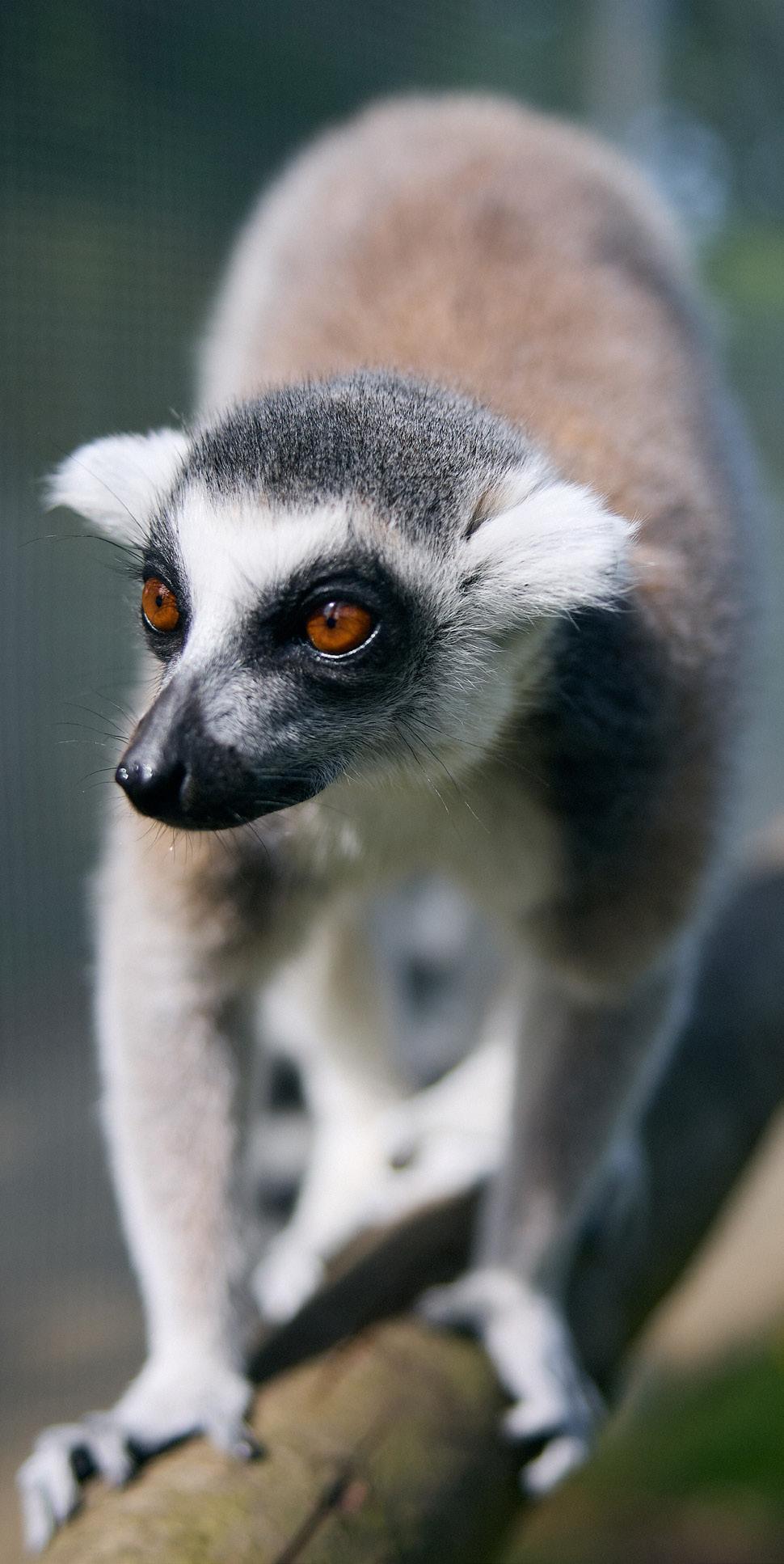
Dasyprocta azarae
Looking a bit like long-legged Guinea Pigs, Agoutis are found in South and Central America, where they patrol forest floors looking for food – and aiming to avoid becoming food for other, larger creatures.
Why do we keep Agoutis? Unobtrusive and shy, our Agouti makes a perfect cage-mate for our group of Squirrel Monkeys.
Agoutis at Bede’s Our Agouti arrived in 2018, from Chessington World of Adventures; born in 2010, she has reached a grand old age for an Agouti.
Chinchilla lanigera
This is the domestic form of a species that is found in the wild in South America. Kept first for its fur, and later for use in scientific research, it has also become a reasonably popular pet - although it is not always straightforward to look after, and can suffer from bad teeth.
Why do we keep Chinchillas? Because they are domesticated, Chinchillas give our pupils the chance to handle animals as they learn how to look after them. Chinchillas at Bede’s Our two animals - Niffler (who is black), and Bowtruckle (who is grey) - came to us as unwanted pets.
Micromys minutus
These tiny European rodents live primarily in fields of cereal crops, where they use their prehensile tails to help them move around freely.
Why do we keep Harvest Mice? They’re a fascinating species - and amongst our collection of exotic animals, it is good to maintain these, and the Hazel Dormice, which are both local.
Harvest Mice at Bede’s We keep a group of surplus males that have been bred at the British Wildlife Centre, in Lingfield.
We have previously worked with two different lemur species: we have kept all-female groups of Black and Ring-tailed Lemurs, gathering experience of caring for these Madagascan primates. We are now awaiting our next challenge: a potential breeding group of a different lemur species - hopefully arriving soon!
In previous years we developed a small collection of African birds, and bred a number of species over the years. However, we have since moved most of our collection to new zoos, using their old aviary to house our pair of Binturongs. We are currently assessing our future direction with our bird collection - we may look to build a larger aviary in which we can mix different birds.
Ptilopsis leucotis
Found in a band spreading across Africa, from Senegal to Kenya, this owl mainly hunts small mammals – mice, rats and so on – but also eats a significant number of invertebrates, including beetles, spiders and scorpions.
Owls at Bede’s Our male owl came to us in 2011, from a private keeper in Yorkshire. He has seen a great deal of change at the Bede’s Zoo since then! In 2024, he was joined by a female, from Birdworld, in Surrey. They are currently the only birds in the zoo; hopefully, that will not remain so for long.
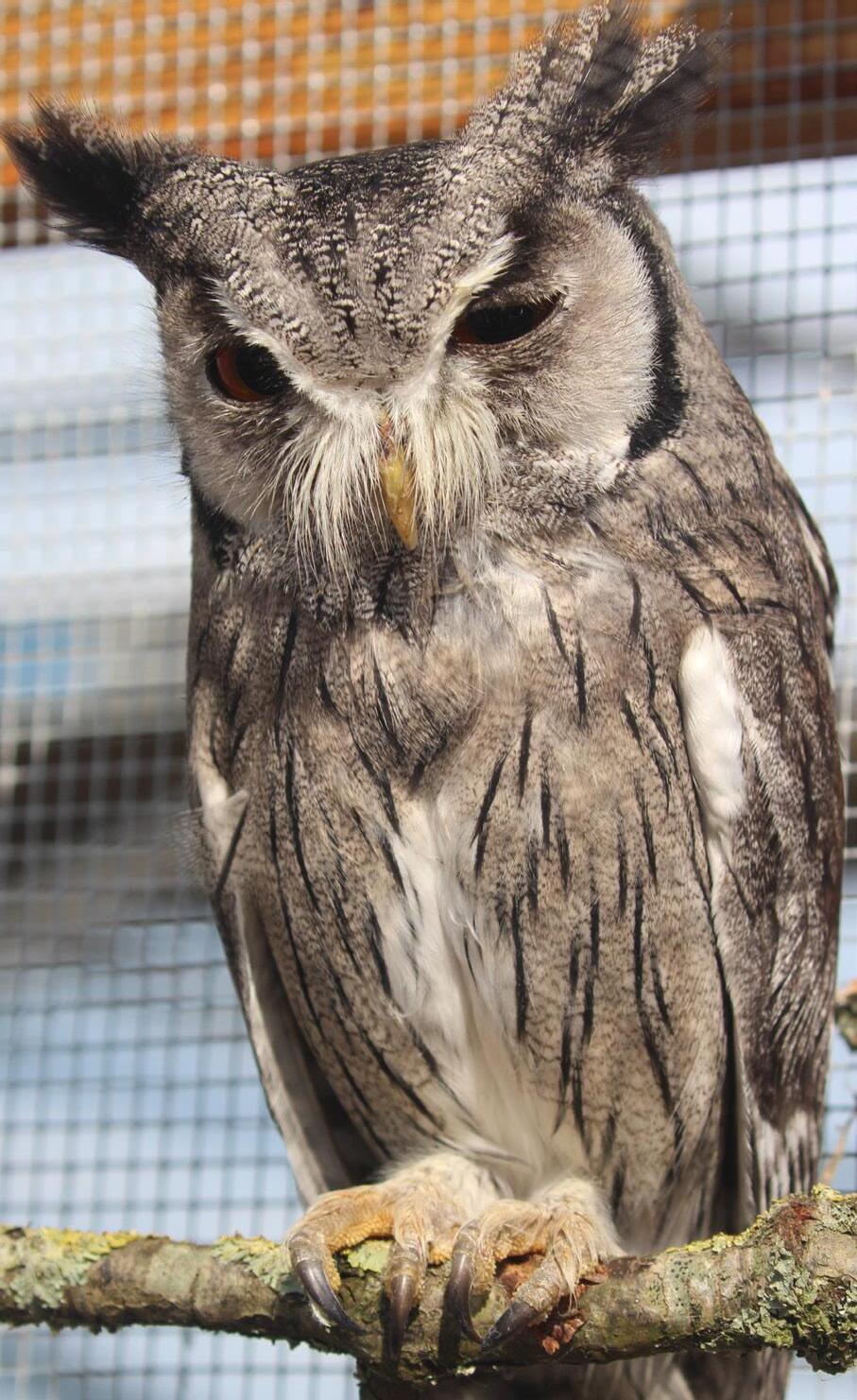
Amphibians and – especially – reptiles have become massively popular as pets over the past 25 years. The Federation of British Herpetologists claims that there are now more reptiles kept in UK homes than there are dogs. Despite this, many vets are less familiar with reptiles than with dogs or cats, and the care given to reptiles in pet shops is often inadequate. Our collection consists mainly of species that are frequently seen in the pet trade, with a number of ‘rescue’ animals amongst them, allowing our pupils to develop a familiarity with these important animals. Fish have long been popular pets - we keep a small collection here, as well as a small number of invertebrates.
Tribolonotus gracilis
Our skinks came to us in 2024, from Sparsholt College; they had been bred there, from parents who were confiscated from smugglers attempting to bring them into the country illegally.
Egernia stokesii
The scientific name of these Australian desert-living lizards honours John Lort Stokes, who served on HMS Beagle - the ship made famous by Charles Darwin.
Brachylophus fasciatus
This rare lizard, from the Lau Islands of the Fijian archipelago, is here at the zoo as part of a European breeding programme. Our animal was hatched at the Cotswold Wildlife Park; she will stay with us until she is needed elsewhere - or until a male is ready to come to us as part of the coordinated European breeding programme.
Crotaphytus collaris collaris
Found in the southern states of the USA, and northern Mexico, this is the state reptile of Oklahoma.


Pogona henrylawsoni
One of the six different species of Bearded Dragon, these are smaller than the more familiar Central Bearded Dragon.
Ctenosaura pectinata
Quite a large lizard, from the west of Mexico, these are the stars of one of our large vivariums. They are rare in zoos, with just a handful of European collections holding them.
Sceloporus malachiticus
A bright green native of Mexico and central America, this species has bred here at Bede’s.
Phelsuma grandis
One of our most striking species; we were delighted to successfully hatch our first Day Gecko youngster in 2024.
Correlophus ciliatus
A popular pet species - our Crested Gecko, Skyla, came to Bede’s having previously been owned by a student at the school.
Gongylophis colubrinus
A fossorial species - one that lives underground - the Sand Boa is not always easy to see.
Thamnophis sirtalis infernalis
This beautiful snake is only held in a tiny number of zoos worldwide, although some private keepers maintain it; ours were bred in the UK. In the summer of 2024, we were delighted to breed this species
Lygodactylus williamsi
This critically endangered lizard is found only in one small area of Tanzania, where it is threatened by the loss of habitat (it lives exclusively on a single species of tree) and collection for the pet trade. Our animal was hatched at Drayton Manor Zoo; it will be joined by others when they are available, and we will, we hope, be able to breed this species ourselves, as part of a coordinated breeding programme.
Eublepharis macularius
A popular pet species. One of our geckos was donated to us in 2010; she is at a pretty grand age for this species.
Pantherophis guttatas
We have bred a number of these snakes – probably the most popularly-kept snake in Britain.
Python regius
Our Royal Pythons were previously maintained by a private keeper who was unable to provide them with the correct level of care; we have brought them back to health.
Laemanctus longipes
This central American lizard is a good climber and an unusual species for us to keep. In the summer of 2024, we bred 11 young iguanasa superb achievement!
Sceloporus serrifer cyanogenys
Found from Mexico to Texas, this lizard is fast-moving and a little bit nervous. In the wild or in captivity, they like to hide away. Our animals were bred at Hamerton Zoo; they are ovoviviparous (live-bearing rather than egg-laying), and we have been very pleased to breed several youngsters ourselves.



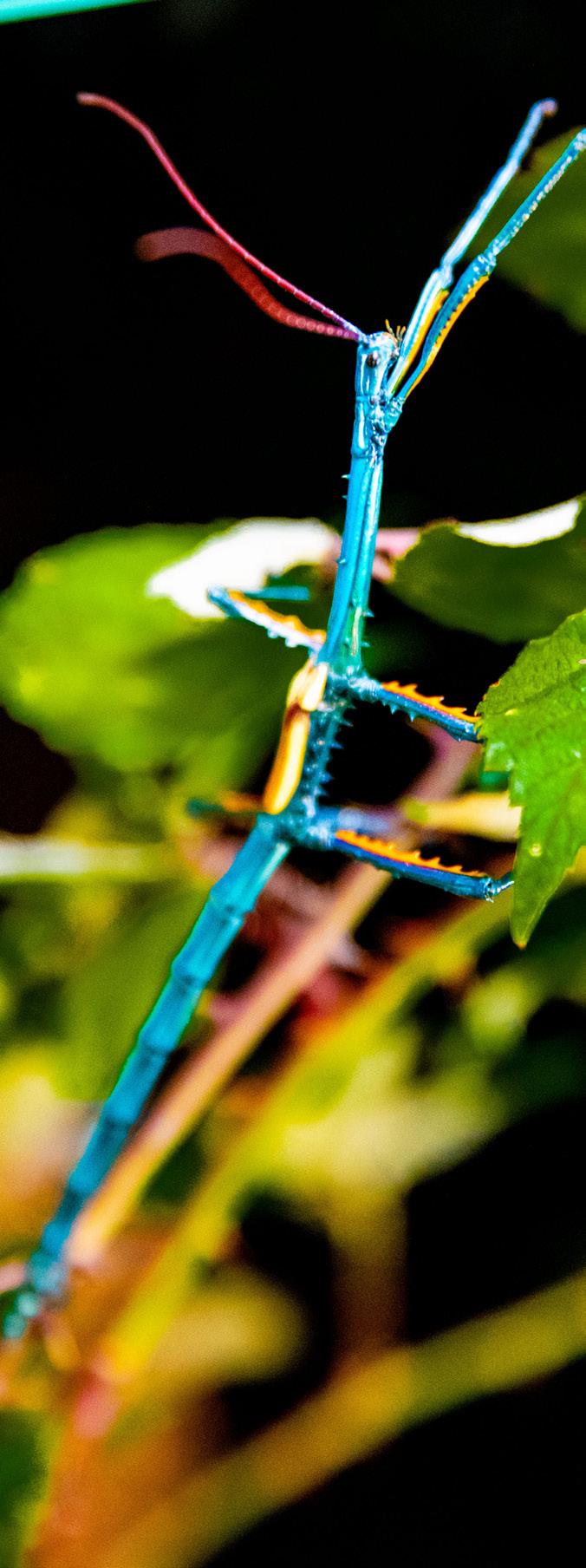

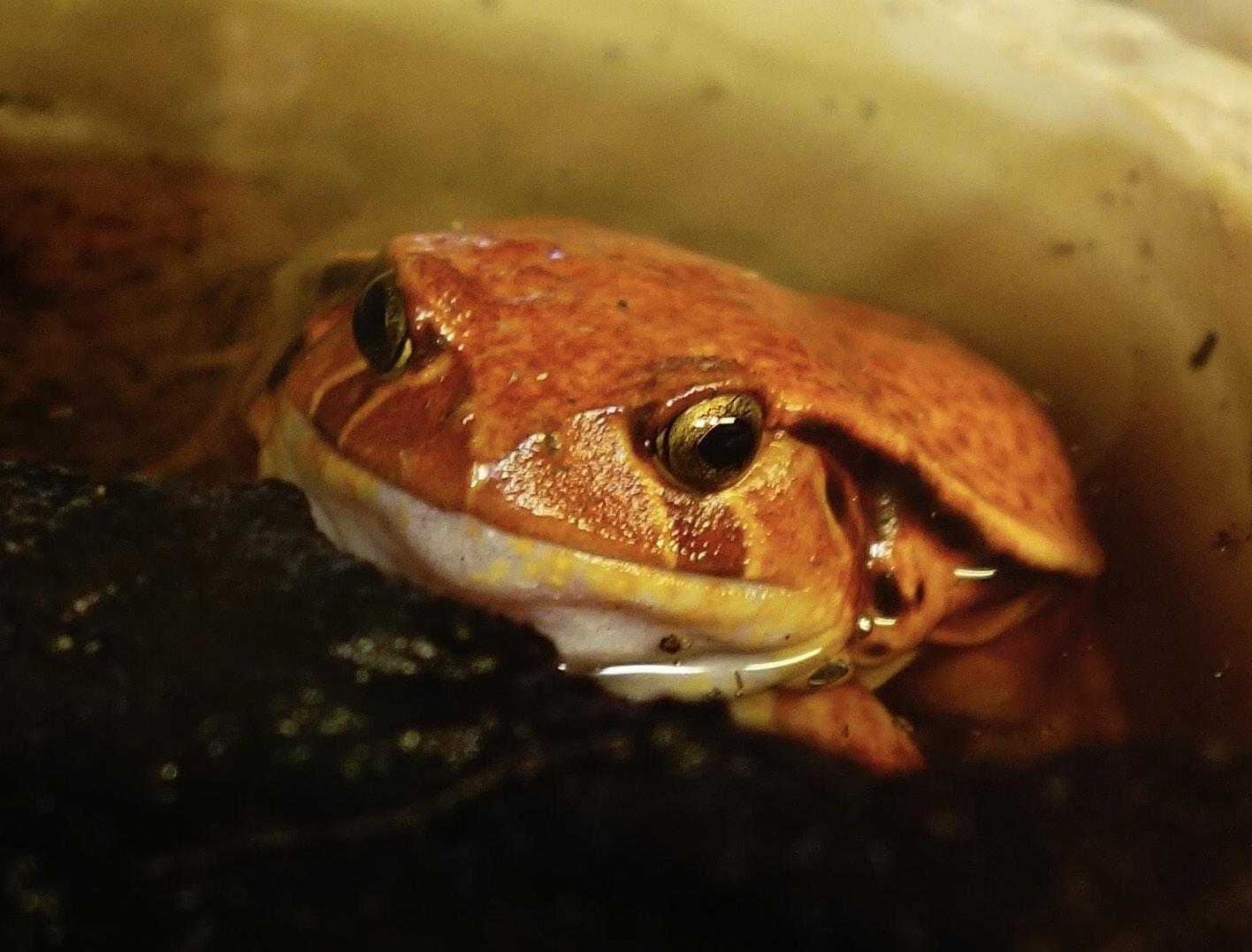
WHITE’S TREE FROG
Litoria caerulea
RED-EYED TREE FROG
Agalychnis callidryas
These live alongside our Casqueheaded Iguanas. They look particularly striking later in the day!
STARRY NIGHT REED FROG
Heterixalus alboguttatus
This tiny species is hard to see - but as they grow, they will become more visible.
FALSE TOMATO FROG
Dyscophus guineti
A native of Madagascar, this beautiful frog has thrived at Bede’s; our four animals have grown hugely since arriving, and we hope they will breed soon
ORIENTAL FIRE-BELLIED TOAD
Bombina orientalis
We have kept this species, from northeast Asia, for a number of years.
AXOLOTL
Ambystoma mexicanum
A familiar species - but a fascinating one! Our AxolotlBlob - was a gift from a private keeper.
NEW GUINEA GIANT SPINY STICK INSECT
Eurycantha calcarata
PINK TIPPED GIANT AFRICAN LAND SNAIL
Archachatina marginata
GIANT AFRICAN LAND SNAIL
Lissachatina fulica
GIANT AFRICAN TRAIN MILLIPEDE
Archispirostreptus gigas
MADAGASCAR HISSING COCKROACH
Gromphadorhina portentosa
MCCLEAY'S SPECTRE STICK INSECT
Extatosoma tiaratum
MADAGASCAN METALLIC BLUE STICK INSECT
Achrioptera manga
CHILEAN ROSE TARANTULA
Grammostola rosea
The genesis of the Bede’s Zoo can be traced back to 2008 when Paul Juniper first came to work in Upper Dicker. As soon as he was ensconced in the school, he started to develop a small collection of animals in his lab: a snake or two, some frogs, a very nice Blue-tongued Skinkall followed, and the idea of doing this properly began to germinate.
The school’s Academic Deputy Head, John Tuson, was convinced of the value that a collection of living animals could bring to Bede’s – and as someone who had previously worked in a zoo himself, and who freely admits to being obsessed with zoos and with animals, he was determined to help to develop such a collection in Upper Dicker.
In 2011, Mr Juniper, and his animals, migrated across the school campus, to their current location: what was once a large storage shed for sports equipment was converted to a classroom, an animal kitchen, and two animal rooms. Three outdoor enclosures – suitable for small carnivores – were included, as well as a few rather homemade wooden cages.
Over the coming years, further outdoor enclosures were added, as the collection grew. A Meerkat enclosure was constructed, as was a rabbit run (utilising anti-seagull netting). David Hartley, a retired Headmaster from Yorkshire who kept a large private collection of different species, donated two mongooses, some fruit bats and a skunk. The current Kinkajou enclosure was created, initially for Macaws, then, later for our African birds. A run of smaller, lightweight, wooden enclosures was built to house Dormice, Red Squirrels, and various birds.
As the school zoo became fully established, we made the decision to expand its area, and to invest in better facilities. In the autumn of 2017, work began on what had previously been a storage yard, to the west of the existing zoo area. The site was cleared, with two substantial houses built by the school’s own estates
team. Three new external enclosures were developed alongside these houses. A brick pathway and a perimeter fence were installed, while the zoo’s old, wooden enclosures were replaced by newly-built exhibits for birds,dormice and Siberian Chipmunks. All of this work was undertaken by the school’s own extraordinary team of craftsmen. The quality of the facilities we have is a testament to their skill, and also to their imagination and ability to find solutions to the problems that such a project inevitably presents.
Meanwhile, in order to be able to keep primates, the school applied for and received approval from DEFRA; we have also registered our collection on ZIMS, a database of captive animals covering all of the world’s professionally-run zoos.
The new facility was officially opened in September 2018, by Dr Christoph Schwitzer, then Chief Zoological Officer of Bristol Zoo, and now the Director of Dublin Zoo.
Growth and development have continued: the arrival of our Binturongs and Grandidier’s Vontsiras are exciting recent highlights, with the 2023 rebuild of our Herptile Room the biggest physical development seen at the zoo since the 2018 construction project.
Bede’s now has a truly unique facility: a zoo which is a teaching resource, which enables pupils to learn and to pursue their interests, and which allows pupils to participate in national and international programmes for the benefit of wildlife.
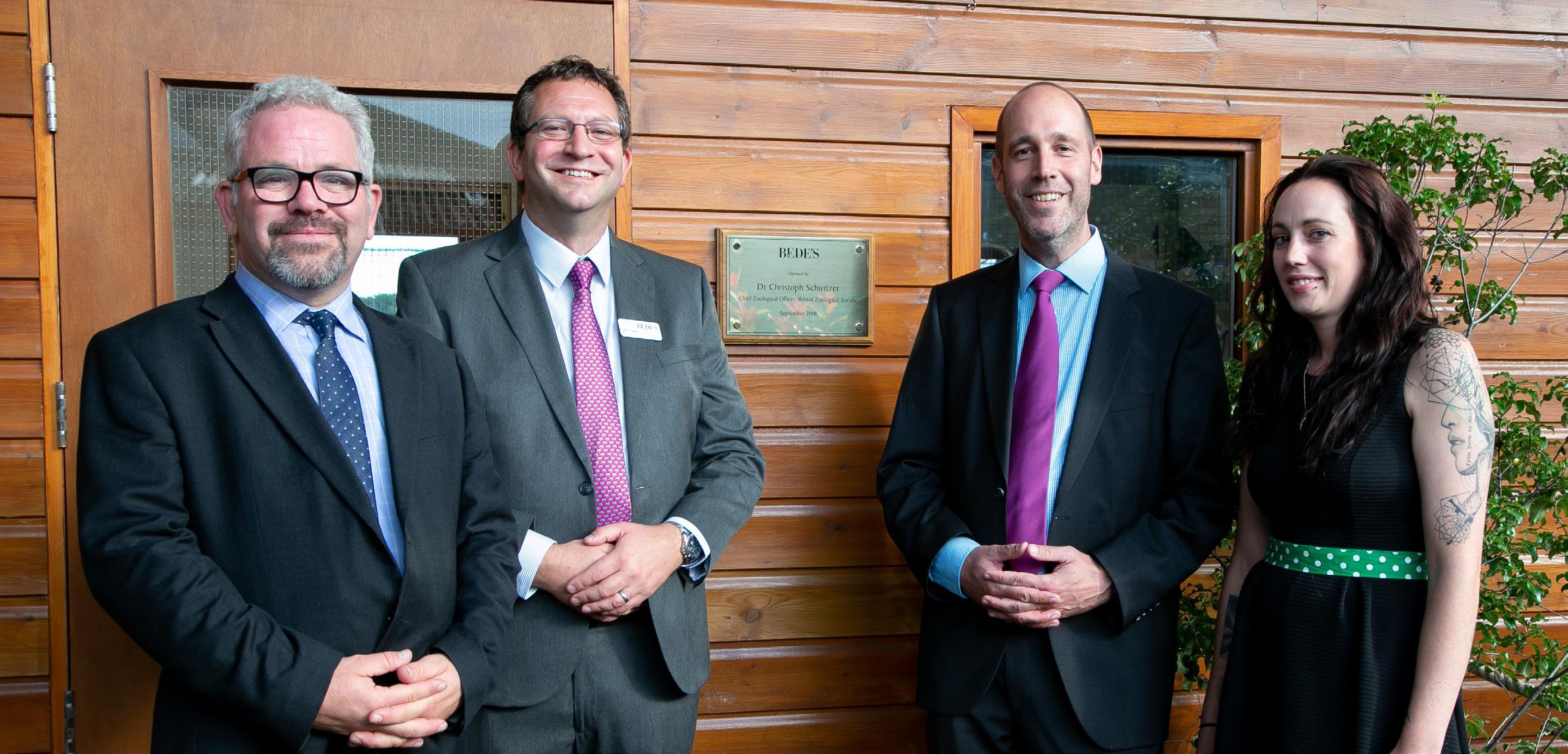


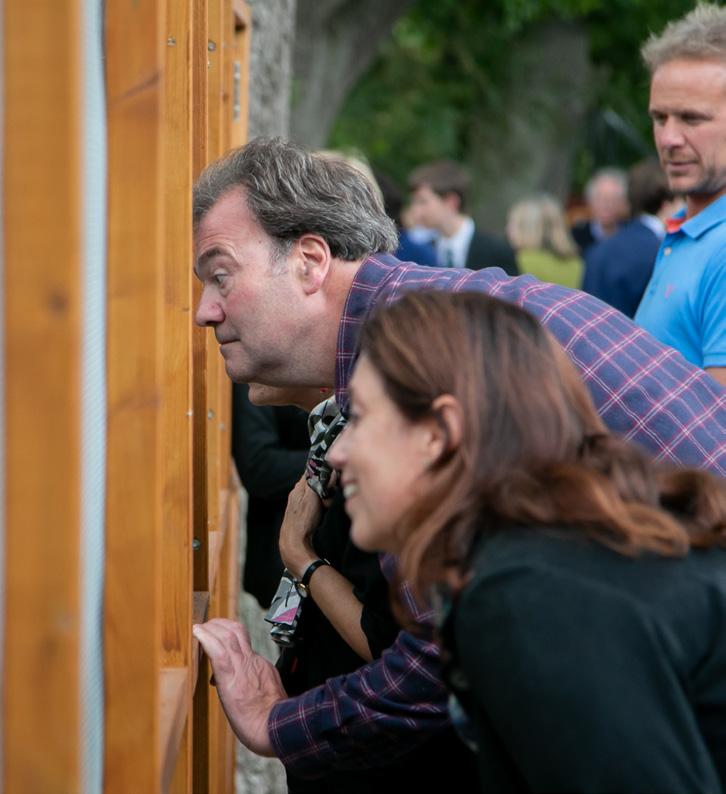

It is unlikely that anyone looking at Bede's would question why we have a Mathematics Department. Or a Dining Hall. Or a string of Football pitches.
We're a school, and schools tend to have such things.
It might not be so immediately obvious, however, why we have a small zoo within the school grounds. A small zoo that, at the last count, contained about 40 species of mammals, birds, amphibians, reptiles, fish and invertebrates.
The answer is several-fold, and the benefits the zoo brings to us, tangible and intangible, are many.
Most obviously, the collection we hold in the zoo forms the cornerstone on which is built the Sixth Form BTEC Animal Management course. This course provides a superb opportunity for those pupils who wish to work with animals, wild or domestic, or who wish to have something unusual to sit alongside their scientific qualifications. Since we started offering the course, in 2013, we have seen 89 pupils complete their BTEC qualification, with around 90% doing so at distinction level. Pupils who have undertaken the course have moved on to study veterinary medicine, veterinary nursing, zoology, conservation –
and many other courses not directly connected with animals. Several of our alumni have gone on to work in zoos and aquaria around Great Britain, and further afield – with one former pupil working at Singapore Zoo, and another monitoring whale and dolphin populations in the English Channel.
The collection also provides the location for one of the school's most popular activities: the Zoological Society. Each week, large numbers of pupils are able to spend their afternoons feeding the Binturongs, cleaning out the Royal Pythons’ vivarium, or rearranging the branching in the home of the Siberian Chipmunks. And as part of their “Twenty-First Studies” curriculum, all of our First Year pupils undertake a course based in the school zoo, exploring issues faced by the wildlife of the world. We want to give our pupils access to a festival of opportunityand the school zoo is very much an important part of that.
The zoo also enables us to look beyond our own school campus. The facility allows the school to participate in a number of national breeding programmes of endangered species: European Polecats, bred in Upper Dicker, have been released into the wild, in the Brecon Beacons; offspring from our Hazel Dormice have, similarly, returned to the wild to help replenish depleted natural populations.
Meanwhile, pupils and staff from the school are involved with the breeding and tracking of wild Dormice, a small population of which is struggling to maintain a foothold in Sussex.
The Bede’s Zoo is not, primarily, a facility for sightseers: it is a working part of a school rather than a visitor attraction. However, each month we welcome many groups to the school zoo – from local schools, disadvantaged children, from our own Prep School, or anyone who is interested in the work we are doing.
Perhaps above all of this, however, we feel that a connection with animals is enriching, calming, fulfilling. Feeding mealworms to a Rankin’s Dragon, gaining the trust of a Kinkajou, or simply appreciating the beauty of our Grandidier’s Vontsirasbeautiful Madagascan carnivores - brings something to the lives of the young people who are privileged to be able to enjoy these opportunities.
And, for all of these reasons, we are delighted that, alongside the school's Media Studies Studio, its Squash Courts and Swimming Pool, its boarding houses and Art School and Cricket Pavilion, there is also a small collection of animals at Bede's which have come to us from all around the world.

Paul Juniper came to work at Bede's, as a Science teacher, in 2008. His background was one which combined education and zoos: his father had been a keeper at London Zoo, and before training as a teacher, Paul had spent a decade working as a zoo keeper, at a variety of British collections, including Southport Zoo, in Lancashire, Port Lympne Zoo, in Kent, and Woburn Safari Park, in Bedfordshire. He had worked with Asian Elephants, with Snow Leopards, and with a plethora of primates. He is the Assistant Head: Boarding at Bede’s.

Peter Jones has taught Science and Animal Management at Bede’s since 2008. He has close links to Africa, having lived in Zambia, Algeria and Malawi, where he worked as a Science teacher and Housemaster in an international school for seven years, before moving to Italy to teach science in Milan for a year. His particular interest is in aquaculture and he has a Masters in Fisheries Biology; his thesis was on the fish of Lake Malawi. He is the Housemaster of Stud House.

John Tuson has been at Bede’s since 1993, and is the school’s Deputy Head. He teaches English, but has significant experience of animals and zoos: between his first and second spells Bede’s, he worked at Newquay Zoo in Cornwall, and he writes frequently for several zoo journals. He has recently published a book about the zoos of Britain and Ireland; this sold out its first print run.
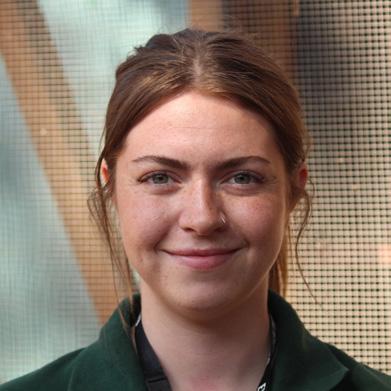

Alex Saunders is a former Animal Management student at Bede’s. She returned to Bede’s to work as a part-time keeper, and in the summer of 2024 was appointed as the manager of the school zoo.
Charlie Adams joined us as a volunteer, before progressing to undertake a full apprenticeship in zoo keeping; he has made himself indispensable in and around the zoo. His favourite species with which to work are the Binturongs.

Hannah Spurgeon was our previous zoo manager; she is now working as a senior keeper at the Hertfordshire Zoo, looking after Siberian Tigers, African Lions and Snow Leopards; we are very pleased that she is continuing to support us as well, bringing her expertise to East Sussex as she oversees some of the work we undertake.
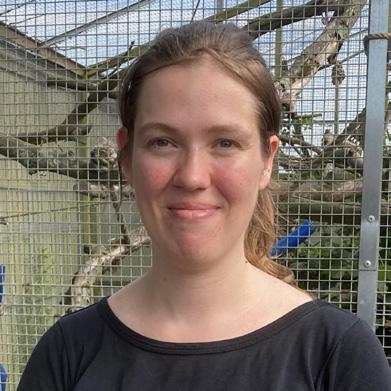
Beccy Withington joined us in the summer of 2024, having previously worked at several zoos, including Marwell and Colchester, and completed a degree in Animal Behaviour and Welfare at the University of Plymouth.

Bede's Zoological Society is already at the forefront of environmental education and wildlife conservation in the UK, partnering with BIAZA Zoos and the People's Trust for Endangered Species to help bolster populations of the endangered Hazel Dormouse here in England. We are now also partnering with the Nyosi Conservation Reserve in the Eastern Cape of South Africa, where Bede's pupils have the opportunity to take part in transformative conservation expeditions, playing an active role in preserving the natural world.
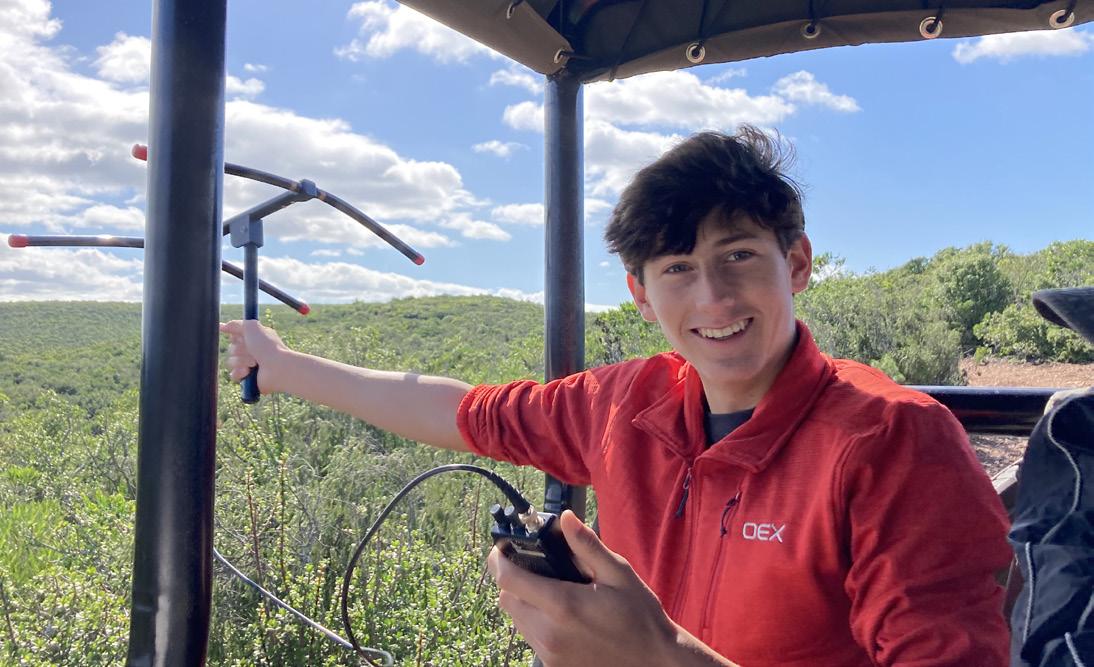
Bede's pupils have contributed significantly to the establishment and maintenance of the Nyosi Conservation Reserve. Our young conservationists engage in vital activities such as clearing invasive vegetation and monitoring wildlife, aiding in the reserve's mission to protect its rich biodiversity. This handson experience not only enriches the pupils' understanding of ecological balance but also strengthens their commitment to global conservation efforts.
The Nyosi Conservation Reserve is a testament to the harmonious coexistence of nature and human activity. As the world's first peri-urban game reserve, Nyosi is dedicated to preserving its diverse biomes and wildlife through sustainable practices and innovative rewilding initiatives. The reserve's commitment to conservation is mirrored by its dedication to the local community.
Nyosi's approach to conservation extends beyond the natural environment to include significant socioeconomic impacts. By creating employment opportunities, supporting local businesses, and engaging in educational outreach, Nyosi fosters a culture of inclusivity, respect, and growth within the local community. These efforts ensure that conservation benefits are shared widely, promoting sustainable development and community resilience.

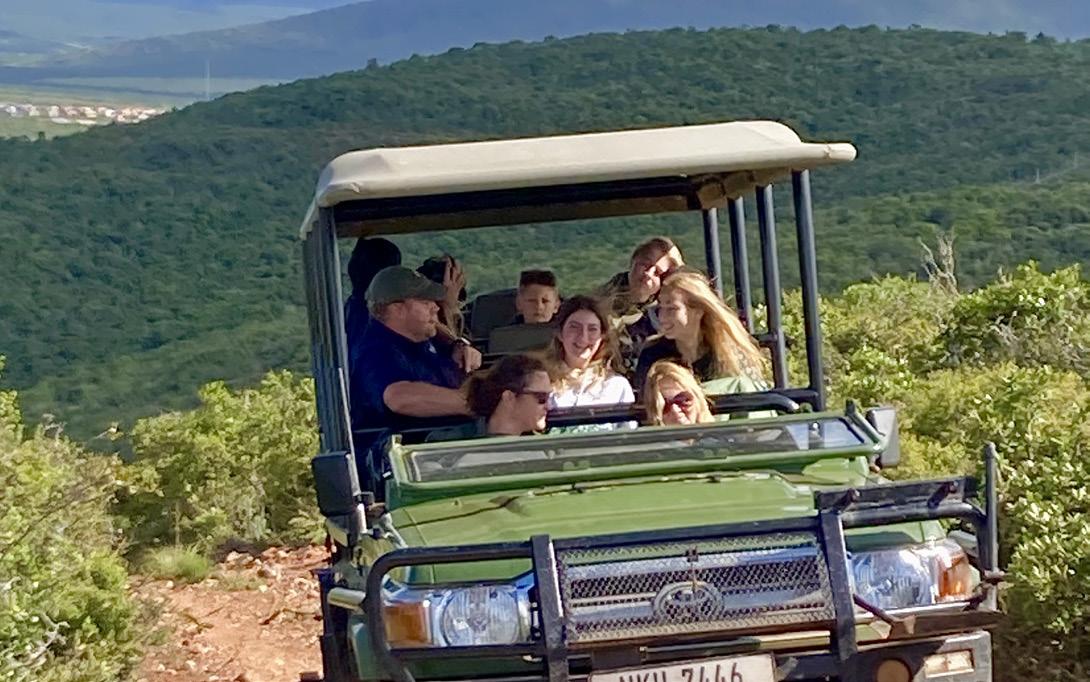
Nyosi Conservation Reserve's vision is ambitious yet profoundly impactful: to rewild landscapes and reconnect people with nature. Through immersive educational experiences and active community engagement, Nyosi aims to cultivate a deeper understanding and appreciation for the natural world. This vision aligns seamlessly with the goals of Bede's Zoological Society, creating a powerful partnership dedicated to conservation efforts.
Bede's Animal Management department is pivotal in promoting conservation awareness and action among young people. Through our collaboration with Nyosi, Bede's is helping to safeguard species such as the African Elephant, Cheetah, Mountain Zebra, and Giraffe. This partnership not only enhances our pupils' educational experience but also contributes to the global effort to protect endangered species and their habitats.
The collaboration between Bede's Zoological Society and Nyosi Conservation Reserve exemplifies the power of education and community engagement in achieving conservation goals. By working together in partnership, our two organisations are making significant strides in preserving biodiversity, empowering local communities, and fostering a culture of conservation. This partnership serves as an inspiring model for how educational institutions and conservation reserves can unite to create a sustainable future for both people and wildlife alike.

Why do I love to spend time in the zoo so much? In part it is because I am deeply interested in animals; and also because the staff are so great.
It is so rewarding when you see a clean enclosure, or when the Casqueheaded Iguana eats the food you gave, or when a shy animal like the Lesser Tenrec or the Agouti pops out in their enclosure.
Also it’s quite a calming and relaxing experience during weekdays and especially on weekends. The routine is quite simple for most of the animals: first you prep the food, then you clean the enclosure up checking for any waste products, after that replace the water bowl. On Saturday zoo activity, I often get into the zone of it so I think compared to other activities I do like mixed martial arts or the drama production it’s a very relaxing activity.
I remember back when I first came and looked around the zoo, I was really surprised in the diversity of species: we do have some relatively common pet species like Royal Pythons, Crested Geckos and Guinea Pigs, but the most surprising animal to me was the Vontsira named Timmy, climbing all around the enclosure, and the bright orange eyes of our Northern White-faced Owl, staring into my soul gently and curiously.
As an exotic animal lover, I appreciate the zoo for the diversity in species - not just having mammals but also the rarer or maybe unusuallooking animals like the Starry Night Reed Frog, which I find very interesting. To be able to have such an array of animals in the school is a real privilege.

Ijoined this school with one ambition: to do the BTEC animal management course in the Sixth Form. At the time I had no clue of what the course entailed. All I knew was that it involved animals - and so it was my dream come true.
After getting through the bugbear of GCSEs, it was brilliant to be absl to start the course - this was why I had wanted to come to Bede’s in the first place. Being a dyslexic student with many other neurological differences, I thrive in a BTEC environment as I will happily talk for days about my favourite topic of animals in agriculture and zoos - what the course is all about.
In the first year we looked at all welfare codes of practice and how businesses should be run ethically, as well as learning how to make a welfare decision based on ethics and religion as everyone has different beliefs. There is also one unit of coursework and hands-on work within the zoo as an introduction to the course.
In the second year you start to create career pathways within the agricultural, zoological and rescue industries as well as many others, to find the best career for you. This unit finishes with a week of work experience at the local Drusillas zoo.
Having this qualification under my belt means that I have a great range of experiences working with and learning about all sorts of animals, opening up many university courses involving agriculture, zoology, conservation, veterinary care and many more; I am hoping to go on to study Agricultural Business Management at Reading University. After this, I would hope to work as a rural surveyorso, a long way from learning to look after Binturongs, but looking after those Binturongs has been a vital part of putting me on the right path.
Bede’s is a large independent school, with around 800 pupils aged from 13 to 18. As one of the youngest major independent schools in the UK (it was founded as recently as 1979) it has never been restricted by its history, and has always been able to approach its curriculum with imagination. The development of the school zoo, to support the BTEC Animal
management course, is but one example of this approach. As well as maintaining a collection of animals, the school strives for academic excellence, sporting and creative success, and the development of young people who are able to find real joy in their education, and can go on to contribute to society in a positive fashion.

To Pete Goodyer, Bede’s Headmaster, who believed in the Bede’s Zoo, and backed it, when less imaginative headmasters would not have done so.
To the Bede’s staff, past and present, who have contributed to the work of the Bede’s Zoo, including Nancy Morton-Freeman (Head of Biology), Jessica Johnson (teacher of Biology) and Dr Andrew Carroll (teacher of mathematics). To Susan Brown-Jones, who is a loyal volunteer at the zoo. And also to the brilliant estates team, who have supported us and helped us with our development.
To Alan Ashby (designaka@hotmail.com) who has produced the information signs which are to be seen within the zoo. To the Cloke family, for their financial support of the zoo, which enabled us to develop our Vontsira enclosure. To Mark and Chris of Team Building With Bite, who have given us invaluable help as we have developed the ‘furnishing’ within some of our enclosures. To Sarah McCoy, our fantastic cleaner, who keeps the non-animal side of the zoo building looking clean and tidy. To Tim Brown, who has enabled us to keep a species as fascinating as the Vontsira. To Damien Lenton for his advice with our reptile collection. And to animal-keeping colleagues across the country who have been supportive of our work, including, in particular, staff at Drusillas, Chessington World of Adventures, Tilgate Nature Centre, Port Lympne Zoo, Hamerton Zoo and Bristol Zoo.
And to the pupils of Bede’s who have embraced and enjoyed the zoo in their midst….

